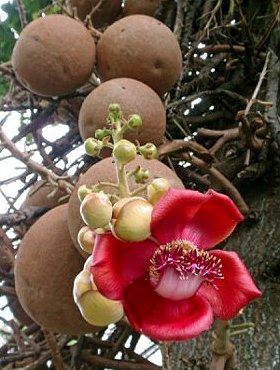
|
|
Cannonball Tree
(Couroupita guianensis) (flowers and fruits)
|
Cannonball Tree -
Couroupita guianensis
Couroupita guianensis, whose common names
include Ayahuma and the Cannonball Tree, is an evergreen tree allied to the
Brazil Nut (Bertholletia excelsa), and is native to tropical northern South
America and to the southern Caribbean. In India it is growing for the past two
or three thousand years at least, as attested by textual records, hence it is
possible that it was native to India also. It's part of the family Lecythidaceae
and grows up to 35m in height.
The Cannonball Tree is so-called because of
its brown cannon ball-like fruits. The majority of these trees outside their
natural environment have been planted as a botanical curiosity, as they grow
very large, distinctive flowers. Its flowers are orange, scarlet and pink in
color, and form large bunches measuring up to 3 m in length. They produce large
spherical and woody fruits ranging from 15 to 24 cm in diameter, containing up
to 200 or 300 seeds apiece.
The Cannon ball tree blooms and bears fruit
simultaneously. The exotic red flowers smell like expensive perfume and bloom
for only one day each. In Asia, the flowers are a symbol of wealth. The
Cannonball Tree was given its species name Coroupita Guianensis by the French
Botanist J.F. Aublet in 1755. The Cannonball tree is native to the tropical
forests of Northeastern South America, especially the Amazon Basin. The
Cannonball tree is known as Ayahuma (head of spirit) in this part of the world.
Among the shamans of the Amazon, the tree is believed to provide protection
against the evil spirits. The English name is derived from the massive fruit
nuts which resemble rusty cannon balls. Thanks to its beauty, the tree has
spread widely all over the world. The Cannonball tree is planted in gardens
elsewhere in the tropics such as in India and Thailand. In India, it was
introduced two to three thousand years back, or may be it was native to India.
It is considered as the holy tree of Shiva and called Naga Linga in India. This
big tree can grow 35 m (115 ft) tall and achieve an 80 cm trunk diameter. The
tree is mainly grown for its beauty, but the soft, light-colored wood is also
utilized to manufacture furniture.
The Cannonball Tree flowers do not have nectar,
so these flowers are mainly visited by bees in search of pollen; outside the
native range of habitat, carpenter bees are considered to be the principal
pollinators. Both the fruit and the flower grow from stalks which sprout from
the trunk of the tree. The Cannonball Tree flowers are found on thick tangled
extrusions that grow on the trunk of the tree; these are found just below the
foliage branches. The extrusions however, can range from two to six feet in
length. The flowers are attached to an upwardly bent, white fleshy disk. The
flowers have six petals, which are large, orange-red, and strongly perfumed. In
pollination, fertile stamens can be found in a ring around reduced style and
stamens. The sterile pollen is located in the anthers. As a bee enters to
pollinate the flower, its back rubs against the ring with fertile pollen; this
allows the bee to carry the fertile pollen to another flower. The differences in
the pollen was noticed by a French Botanist in 1825. This discovery was made by
Antoine Porteau. The differences in the pollen are as follows: the pollen of the
ring stamens is fertile, while the hood pollen is sterile.
The fruits and the flowers burst straight from
the trunk and the old trees have the whole lower part of the trunk covered. The
cannon ball –like fruits can be up to 20 cm. They ripen for approximately nine
months and then fall to the ground, often popping broken and causing the sound
of a small explosion. When reacting with air, the fruit flesh turns bluish-green
and smells unpleasant and fermented. The flesh is edible for animals and for the
Shamans of the Amazon, this powerful nourishment is a part of their diet. For
other people the fruit can even be poisonous and might cause a serious allergic
reaction. Individual seeds within the "ball" are coated with hair,
which is thought to protect the seed when it is ingested and may also help in
the passage of the seed through the intestines. The hard fruit shell is used as
containers or ornaments. Like coconut palms, the trees should not be planted
near paths or near traffic-filled areas, as the heavy nut is known to fall
without notice.
The trees are grown extensively in Shiva
temples in India. In Hindi it is called Shiv Kamal. It is called the Nagalingam
tree in Tamil. In Bengali, it is called Nagkeshar. The flowers are called
Shivalinga flowers in Hindi; Nagalinga Pushpa in Kannada; Nagamalli flowers or
Mallikarjuna flowers in Telugu. Hindus revere it as a sacred tree because the
petals of the flower resembles the hood of Naga, a sacred snake, protecting a
Shiva Lingam, the stigma. In Sri Lanka, Thailand and other Buddhist countries
the tree is often planted at Buddhist temples. It is here mistaken as the Sala
tree, Shorea robusta, the tree under which the Buddha passed away and under
which the previous Buddha Vessabhu attained enlightement.
The Cannon ball tree possesses antibiotic,
antifungal, antiseptic and analgesic qualities. The trees are used to cure colds
and stomach aches. The juice made from the leaves is used to cure skin diseases,
and the Shamans of South America have even used tree parts for treating malaria.
The inside of the fruit can disinfect wounds and young leaves ease toothache.
Source:
http://en.wikipedia.org/wiki/Couroupita_guianensis
http://www.forestgeneration.com/cannonball-tree.html
